FUEL FILLER CHANGED wo/REMOVING FENDER
- Thread starter MAD IN NC
- Start date
You are using an out of date browser. It may not display this or other websites correctly.
You should upgrade or use an alternative browser.
You should upgrade or use an alternative browser.
Thank you..duplicated in S Fl.
My gal required the replacement fuel filler tube. I provided these detailed instructions to my tech and he gladly received the input..I just received a call to pick up my car and I asked if he needed to remove the fender..His reply" NO..everything went just fine.."
Thanks :thumbsup
*********************I start a thread earlier about the P0455 code http://www.fordgtforum.com/forums/showthread.php?t=11327 and just got back from the dealer.
For any of us who have thrown a P0455 code for Evap Cntr failure the fix is the changing of the fuel filler unit typically due to a bad "flapper" valve.
In the Ford repair instructions they say to 1.) remove fender liner, 2.) remove fender, 3.) remove gas cap lever and assy THEN 4.) remove the three screws to remove the unit.
When the mechanic and I looked at the fuel filler part after removal of the fender liner against the new replacement part it became obvious that the top piece is plastic for the first shutter door or serated gas nozzle door is attached to the aluminum fuel filler tube via two screws of which upon removal you can slide the plastic piece off.
When you look under the fender you can see the two screws that hold the top plastic piece to the fuel filler neck
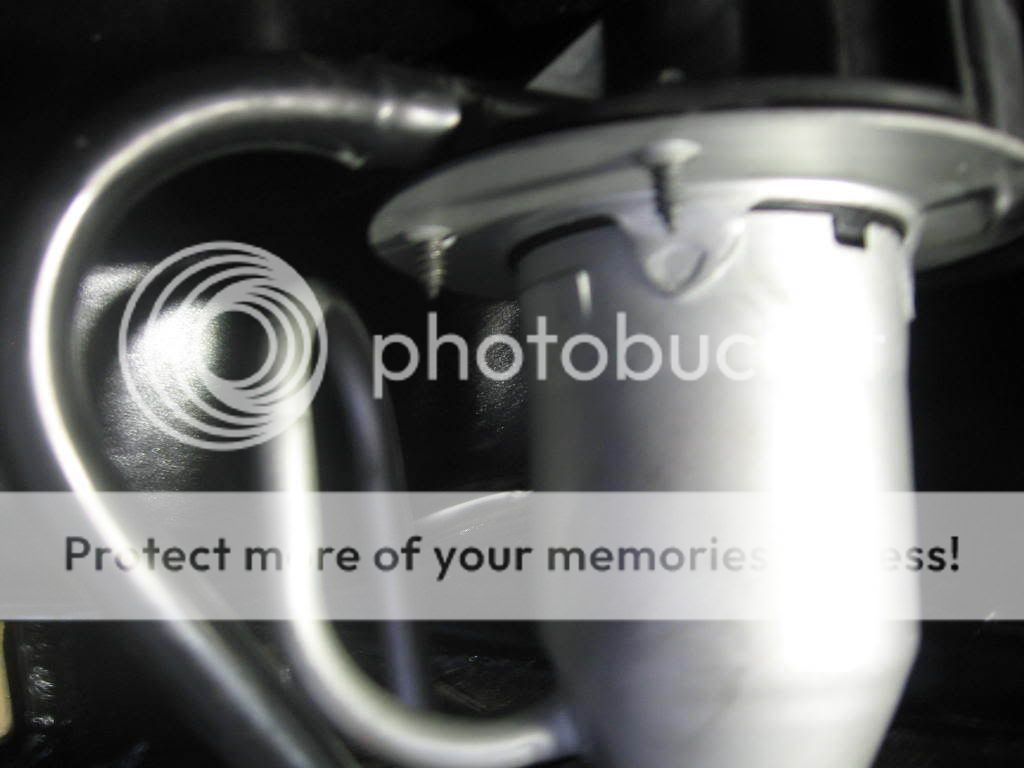
If you remove these 2 screws ......
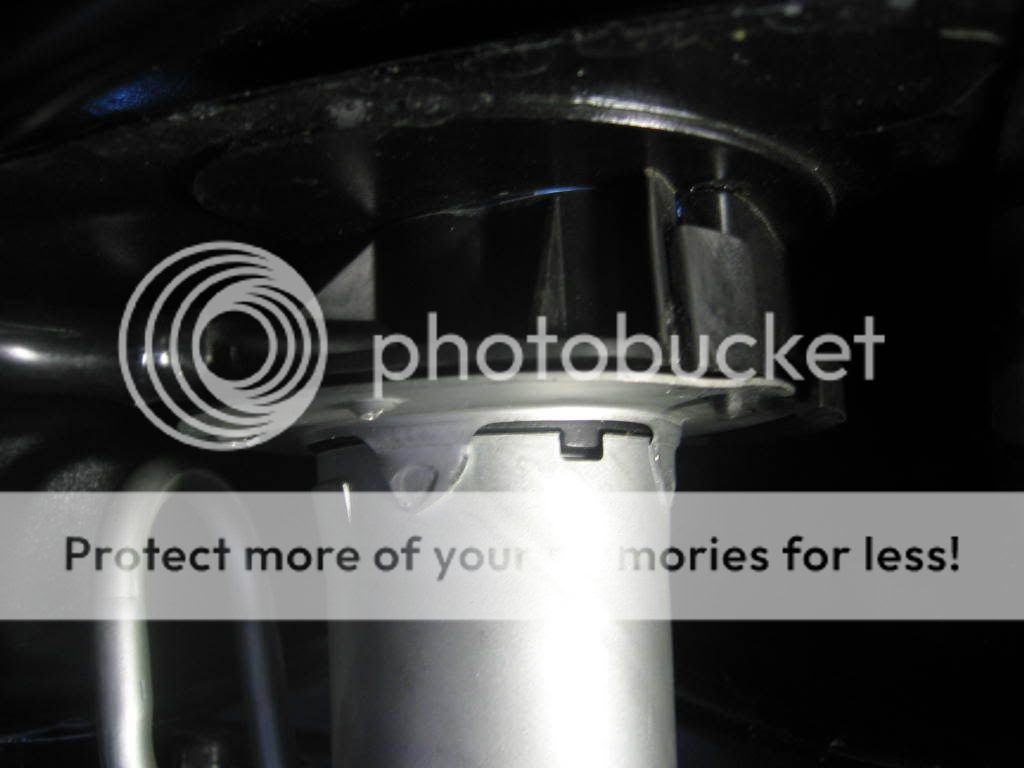
you can slide the filler tube off the plastic top piece while it is still mounted in the car!
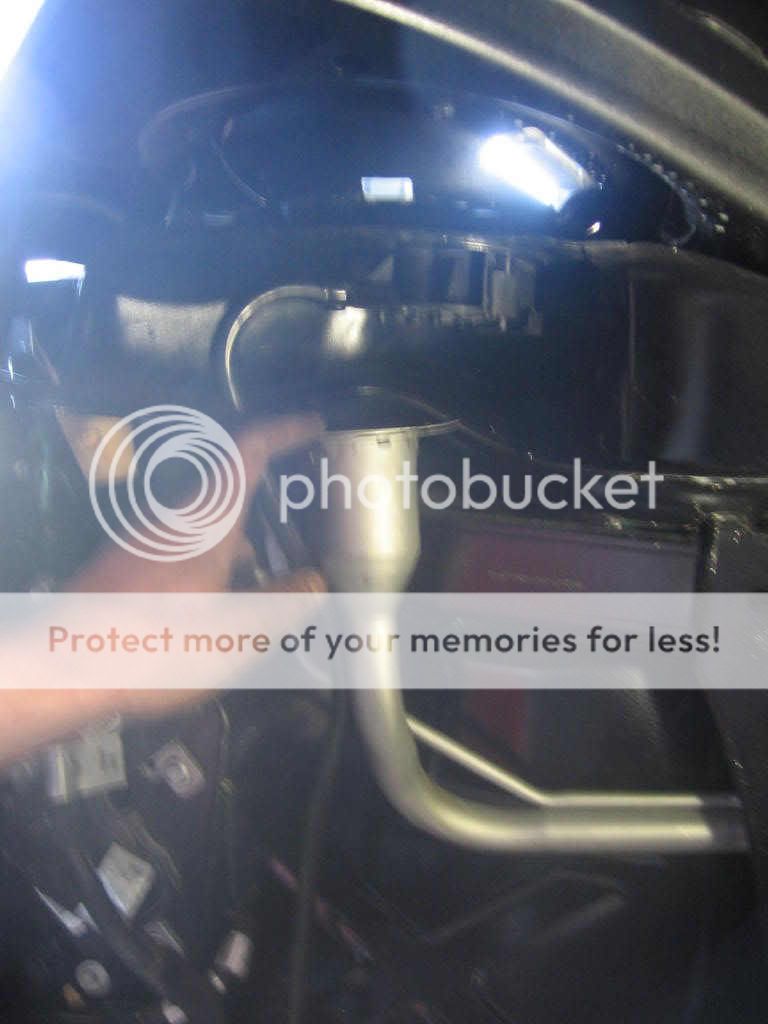
then remove the top plastic shutter from the new replacement part
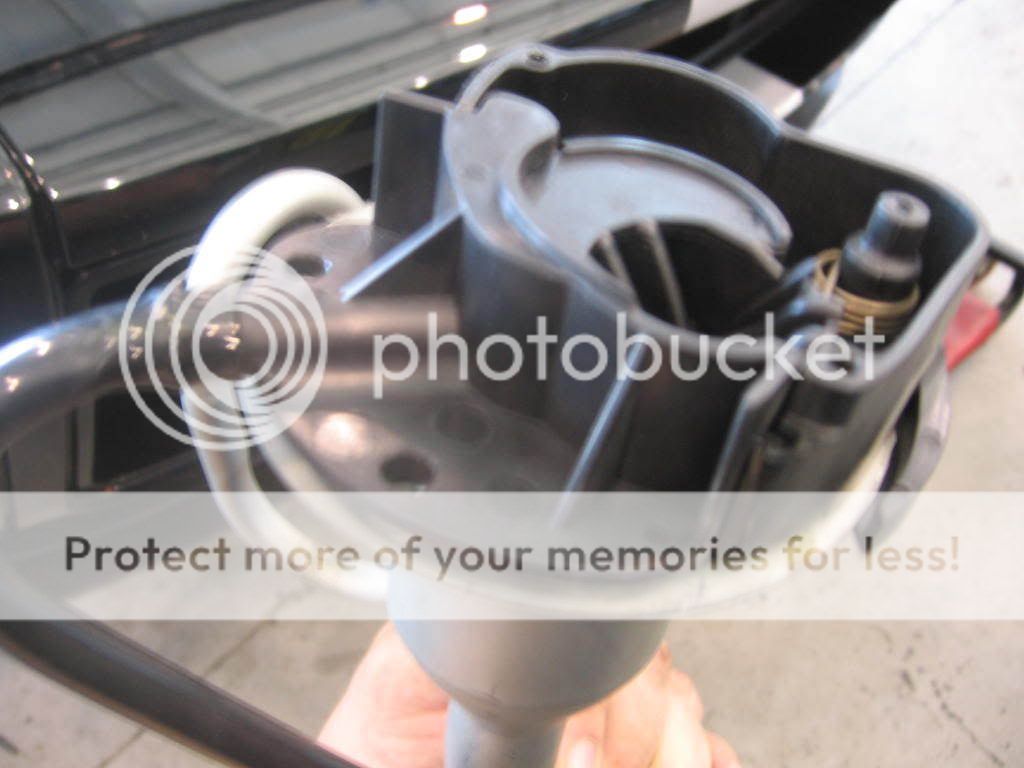
and here is that damn valve that rips so easily - GOOD SHOWN BELOW! [new]
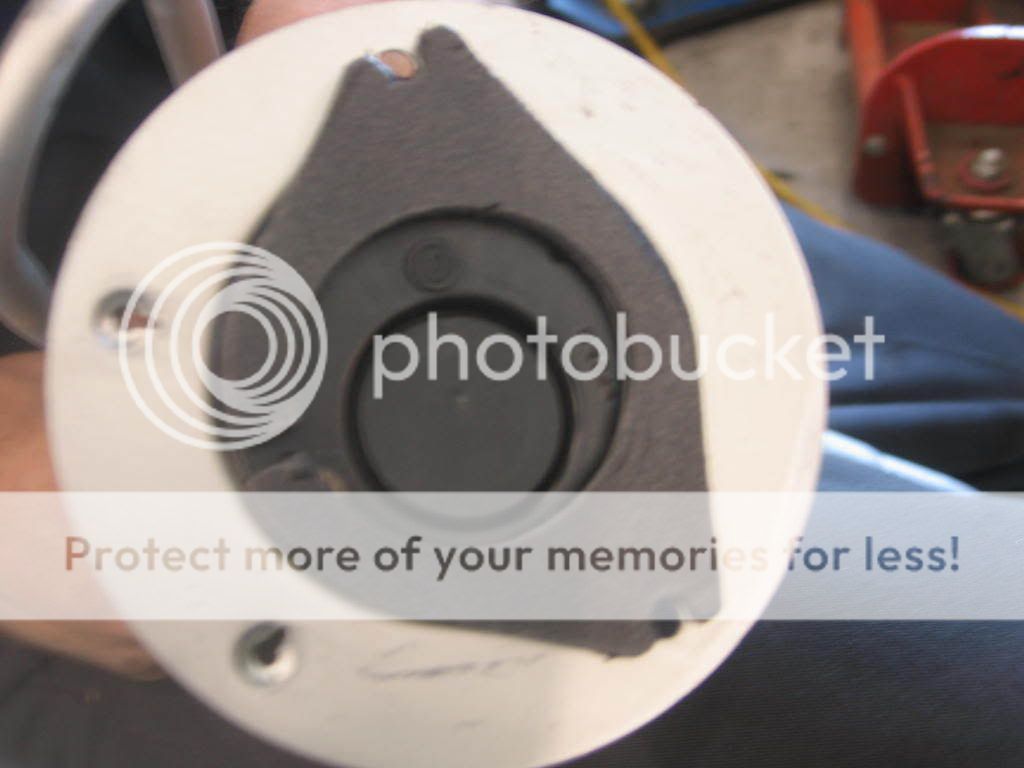
and the old DEFINTELY BROKEN PIECE OF CRAP PART!
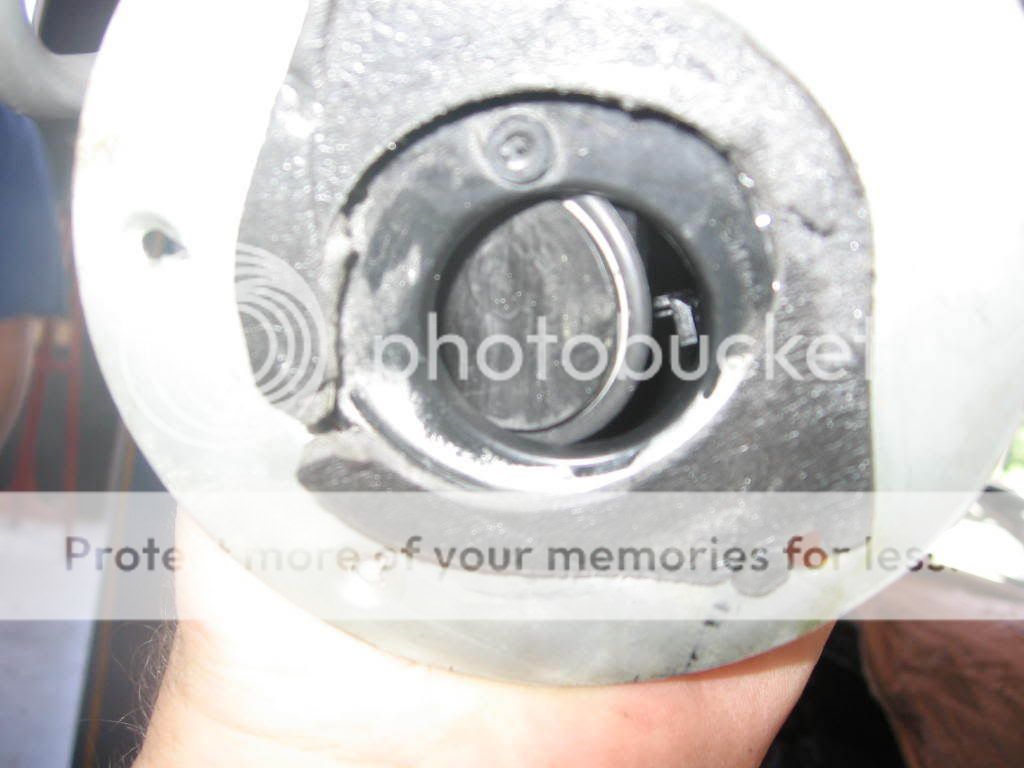
The other part required removal of the "trunk" to get to the clap that connects the fuel filler tube to the gas tank which at that time you can remove the old broken part and in reverse slip in the new repalcement part, connect the vacumn line, reattach to gas tank, reinstall trunk and finally re-install fender liner!
We then ran the full diagnostics EVAP cycle which showed 100% pass - ZERO loss meaning fix was good! Then we did an oil change and checked the trans magnetics, topped off the transfluid buttoned her back up and went for a Sushi lunch in Fuquay- Varina North Carolina!
Not a single flucuation in the RPM's at all when coming to a stop! No more stalling! PERFECTLY SMOOOOOOOTH NOW!
So yes Virginia, you can change the fuel filler tuber without removal of the fender.
Now a Happy GT owner going drinking :cheers :thumbsup
Happy 4th everybody
My gal required the replacement fuel filler tube. I provided these detailed instructions to my tech and he gladly received the input..I just received a call to pick up my car and I asked if he needed to remove the fender..His reply" NO..everything went just fine.."
Thanks :thumbsup
Can we get a head count how many have had needed the filler neck replaced?
I'm working on my third!
Third? :eek Are you "babying" the 'nozzle into the filler tube to try to prevent cuts, etc., etc.? If not, you might try that technique & see if it stops the replacement pblm.
BlackICE
GT Owner
I had to do the fix once so far at about 5K miles. Broke during Rally III. My flapper valve BROKE COMPLETELY OFF blocking the filler hose! Gas fillups were taking more than 20 minutes!
This post and Shadowman were a great help in getting it repaired. Not as bad as I thought. :thumbsup
This post and Shadowman were a great help in getting it repaired. Not as bad as I thought. :thumbsup
TifosiTed
GT Owner
I aggree with EP. I am so scared of busting the filler flap that I approach it with the filler nozzle like a,........well,..... like a virgin.:tongue
After reading about all these problems, I just took the easy way out. Went to the parts store, bought a plastic fuel funnel that fits the fuel filler and has a long ribbed tube up to the funnel itself. I keep fuel at home and just insert the soft plastic funnel into the filler on the GT when I want to add gas from a can, or I can use a hand pump from comtainers. I then bought a second funnel and cut the bottom plastic part off and carry it in the car to use as a sleeve when I need to fill at a gas station. This way, no metal part ever contacts the fuel filler tube on the car and no possibility of scratches damaging the tube.
That's exactly how I feed my baby race gas too !
After reading about all these problems, I just took the easy way out. Went to the parts store, bought a plastic fuel funnel that fits the fuel filler and has a long ribbed tube up to the funnel itself. I keep fuel at home and just insert the soft plastic funnel into the filler on the GT when I want to add gas from a can, or I can use a hand pump from comtainers. I then bought a second funnel and cut the bottom plastic part off and carry it in the car to use as a sleeve when I need to fill at a gas station. This way, no metal part ever contacts the fuel filler tube on the car and no possibility of scratches damaging the tube.
I also use a filler to feed my car race gas. However, I use regular pumps all the time, so I guess some of us are just more skillful in our insertion technique. :lol (jk)
Silverbullitt
GT Owner
I also use a filler to feed my car race gas. However, I use regular pumps all the time, so I guess some of us are just more skillful in our insertion technique. :lol (jk)
I don't think it is the size. It is how you use it.:cheers
After reading about all these problems, I just took the easy way out. Went to the parts store, bought a plastic fuel funnel that fits the fuel filler and has a long ribbed tube up to the funnel itself. I keep fuel at home and just insert the soft plastic funnel into the filler on the GT when I want to add gas from a can, or I can use a hand pump from comtainers. I then bought a second funnel and cut the bottom plastic part off and carry it in the car to use as a sleeve when I need to fill at a gas station. This way, no metal part ever contacts the fuel filler tube on the car and no possibility of scratches damaging the tube.
'EXCELLENT IDEA! :thumbsup:thumbsup
Ok, I looked over some of the past postings but it’s not comprehensive and I’m not 100 pct sure all those listed have had this same issue.
So, if I’ve listed someone incorrectly I apologize, just let me know and I’ll make the correction. Again the below is a listing for vacuum stalling, fuel filler neck leak and replacement fix.
Mad In NC (thanks so much for the fantastic photos and alternative R&R procedure).
Steward W
Black Ice (changed out at around 5K)
GT374
Kumar
GT Joey,
Digman1
Rick430
Enzo BTR
Robert
HiloDave
AnalogDesigner
Dave5088
barondw
Glord
Mark06GT
GT374
Phil
GWBartlett (replaced twice)
SKGT
Chris A.
ZeroVette
Tiger 6
Gforce
Joseph Tomarchio, Jr.
Track Day (going on my third) High mileage / over 30K, but filling the car with white gloves after the first one went bad, second filler neck only caused stalling after filling the tank on occasions, so codes only came up after some tank up situations, thus it was difficult to get it to the dealer when the problem was occurring, smoke test at Ford with half a tank of fuel proved the filler is leaking and the cause once more of the stalling, still not much hope the third one will last any longer than the first two as they list the same part number.
Anyone else out there we can add to the list?
Others have posted here that the fuel filler neck:
“falls under the Federal emissions warranty as such it does “NOT” expire at 3 years 36K; it is covered for 7 years and or 70K miles”
or covered for:
“8 years 80,000 miles”
Unfortunately after speaking with Ford these statements are not accurate.
As a result I suspect many more will be feeling this same pain soon enough as we all use these fantastic cars more and more.
So, if I’ve listed someone incorrectly I apologize, just let me know and I’ll make the correction. Again the below is a listing for vacuum stalling, fuel filler neck leak and replacement fix.
Mad In NC (thanks so much for the fantastic photos and alternative R&R procedure).
Steward W
Black Ice (changed out at around 5K)
GT374
Kumar
GT Joey,
Digman1
Rick430
Enzo BTR
Robert
HiloDave
AnalogDesigner
Dave5088
barondw
Glord
Mark06GT
GT374
Phil
GWBartlett (replaced twice)
SKGT
Chris A.
ZeroVette
Tiger 6
Gforce
Joseph Tomarchio, Jr.
Track Day (going on my third) High mileage / over 30K, but filling the car with white gloves after the first one went bad, second filler neck only caused stalling after filling the tank on occasions, so codes only came up after some tank up situations, thus it was difficult to get it to the dealer when the problem was occurring, smoke test at Ford with half a tank of fuel proved the filler is leaking and the cause once more of the stalling, still not much hope the third one will last any longer than the first two as they list the same part number.
Anyone else out there we can add to the list?
Others have posted here that the fuel filler neck:
“falls under the Federal emissions warranty as such it does “NOT” expire at 3 years 36K; it is covered for 7 years and or 70K miles”
or covered for:
“8 years 80,000 miles”
Unfortunately after speaking with Ford these statements are not accurate.
As a result I suspect many more will be feeling this same pain soon enough as we all use these fantastic cars more and more.
BlackICE
GT Owner
I have read more and more of cars from Ford will be using this type of gas cap. I hope the caps used will be of a newer design, or the warranty costs will hamper Ford's return to profitability.
I have read more and more of cars from Ford will be using this type of gas cap. I hope the caps used will be of a newer design, or the warranty costs will hamper Ford's return to profitability.
+ 1
Since its an emission related item I believe that it is the manufacturers responsibility to replace for as long as you own the car. Had a fuel cap problem with my Lexus and they told me it was Lexus' responsibility as long as I owned the car. They did say that some older cars may have slighting different rules governing them. For example a 10 year old LExus owner would have to replace the gas cap himself.
Perhaps Chip or one of the other members with real knowledge can elaborate.
There is the second issue of Ford not having spares and that could be far more serious than who pays for the repair.
I am also working on my 3rd filler, and have always babied the nozzle into the filler. I just think its either a poor design or unfinished design that was never properly debugged.
Perhaps Chip or one of the other members with real knowledge can elaborate.
There is the second issue of Ford not having spares and that could be far more serious than who pays for the repair.
I am also working on my 3rd filler, and have always babied the nozzle into the filler. I just think its either a poor design or unfinished design that was never properly debugged.
Right you are, barondw! This repair would fall under the Federal Emissions Warranty and, as such, would be covered by the manufacturer for a period of 8 years or 80,000 miles.
But who do you contact when FoMoCo denies the claim because my car is out of warranty? That's where I am right now. Any help appreciated.
Dave
I think it falls under federal regulations, but they don't have to do it for free like warranty work. I beleive it's at cost. Same thing with mirrors.
BlackICE
GT Owner
From
http://www.epa.gov/obd/warranties.htm#a
A. PERFORMANCE WARRANTY
The Performance Warranty covers repairs which are required during the first 2 years or 24,000 miles of vehicle use because the vehicle failed an emission test. Specified major emission control components are covered for the first 8 years or 80,000 miles. If you are a resident of an area with an Inspection and Maintenance (I/M) program that meets federal guidelines, you are eligible for this warranty protection provided that:
Your car or light-duty truck fails an approved emissions test; and
Your vehicle is less than 2 years old and has less than 24,000 miles (up to 8 years/80,000 miles for certain components); and
Your state or local government requires that you repair the vehicle; and
The test failure does not result from misuse of the vehicle or a failure to follow the manufacturers' written maintenance instructions; and
You present the vehicle to a warranty-authorized manufacturer representative, along with evidence of the emission test failure, during the warranty period.
During the first 2 years/24,000 miles, the Performance Warranty covers any repair or adjustment which is necessary to make your vehicle pass an approved, locally-required emission test and as long as your vehicle has not exceeded the warranty time or mileage limitations and has been properly maintained according to the manufacturer's specifications.
B. DESIGN AND DEFECT WARRANTY
The Design and Defect Warranty covers repair of emission related parts which become defective during the warranty period. The Design and Defect warranty for model year 1995 and newer light-duty cars and trucks is outlined below:
Design and Defect Warranty Coverage for 1995 and newer light-duty vehicles:
Emission control and emission related parts are covered for the first 2 years or 24,000 miles of vehicle use; and
Specified major emission control components are covered for the first 8 years or 80,000 miles of vehicle use.
According to federal law, an emission control or emission related part, or a specified major emission control component, that fails because of a defect in materials or workmanship, must be repaired or replaced by the vehicle manufacturer free of charge as long as the vehicle has not exceeded the warranty time or mileage limitations for the failed part.
Design and Defect Warranty coverage may vary depending on the type of vehicle you have (e.g., heavy-duty trucks, motorcycles or recreational vehicles have different time and mileage requirements). To determine the length of warranty coverage that applies to your vehicle, look for the emissions warranty information in your owner's manual or warranty booklet. If you own a California vehicle, you may be entitled to additional warranty coverage.
The owner's manual or warranty booklet will also provide you with guidance on the procedures for obtaining warranty coverage. If you have questions about the emissions warranties on your vehicle or need help in filing a warranty claim, contact your local car dealer or the manufacturer's zone or regional representative listed in your owner's manual or warranty booklet.
What Emission Control and Emission Related Parts Are Covered by The Design and Defect Warranty?
An emission control part is any part installed with the primary purpose of controlling emissions. An emission related part is any part that has an effect on emissions. Listed below are some examples of parts or systems which fall under these definitions. A more complete list can be found in your owner's manual/warranty booklet. If any of the parts listed below fail to function or function improperly because of a defect in materials or workmanship, causing your vehicle to exceed federal emission standards, they should be repaired or replaced under the emissions warranty if your vehicle is less than 2 years old and has been driven less than 24,000 miles. One manufacturer may use more parts than another, so the following list is not complete for all vehicles.
EMISSION CONTROL PARTS
Exhaust Gas Conversion Systems: oxygen sensor, thermal reactor, catalytic converter, dual-walled exhaust pipe
Exhaust Gas Recirculation System: EGR valve, thermal vacuum switch, EGR solenoid, EGR spacer plate, EGR backpressure transducer, sensor and switches used to control EGR flow
Evaporative Emission Control System: purge valve, fuel filler cap, purge solenoid, vapor storage canister, and filter
Positive Crankcase Ventilation (PCV) System: PCV valve, PCV solenoid
Air Injection System: Air pump diverter, bypass, or gulp valve, reed valve, anti-backfire or deceleration valve
Early Fuel Evaporative (EFE) System: EFE valve, thermal vacuum switch, heat riser valve
Fuel Metering System: electronic control module (unit) or EFI air flow meter, computer command module or mixture control unit, deceleration controls, electronic choke, fuel injectors, fuel injection units and fuel altitude compensator sensor, bars or rails for EFI or TBI systems, mixture settings on sealed fuel mixture control solenoid, diaphragm or other systems, fuel metering components that achieve closed/other feedback control sensors/loop operation switches and valves
Air Induction System: thermostatically controlled air cleaner, air box
Ignition Systems: electronic spark advance timing advance/retard systems, high energy electronic ignition
Miscellaneous Parts: hoses, gaskets, brackets, clamps, and other accessories used in the above systems
EMISSION RELATED PARTS
These are examples of other parts of your vehicle which have a primary purpose other than emissions control but which nevertheless have significant effects on your vehicle's emissions. If any of these parts fail to function or function improperly, your vehicle's emissions may exceed federal standards. Therefore, when any of the parts of the following systems are defective in materials or workmanship and have failed in a way that would be likely to cause your vehicle's emissions to exceed federal standards, they should be repaired or replaced under the emissions warranty:
Fuel Injection System: fuel distributor
Air Induction System: turbocharger, intake manifold
Exhaust System: exhaust manifold
Ignition System: distributor, spark plugs, ignition wires and coil
Miscellaneous Parts: hoses, gaskets, brackets, clamps, and other accessories used in the above systems.
What Are Specified Major Emission Control Components?
There are three specified major emission control components, covered for the first 8 years or 80,000 miles of vehicle use on 1995 and newer vehicles:
Catalytic converters.
The electronic emissions control unit or computer (ECU).
The onboard emissions diagnostic device or computer (OBD).
Catalytic converters are critical emission control components that have been installed on most cars and trucks manufactured since 1975. Since engines don't burn fuel completely during the combustion process, the exhaust contains a significant amount of harmful pollutants such as carbon monoxide, hydrocarbons, and oxides of nitrogen. The catalytic converter aids the conversion of these pollutants to less harmful substances such as carbon dioxide, water vapor, nitrogen, and oxygen before the exhaust is expelled into the environment.
The electronic emissions control unit or computer monitors certain powertrain functions and controls various operating parameters to help the vehicle run efficiently and with the lowest possible emissions. Ignition, transmission function, air injection, exhaust gas recirculation (EGR), engine operating temperature and fuel system parameters are some of the systems monitored and/or controlled by the electronic emissions control unit.
The onboard emissions diagnostic device monitors the operation of a vehicle's emission control system and alerts the driver with a dashboard light when malfunctions occur. The system will record where the problem is occurring and assist automotive technicians in diagnosing and repairing emission control malfunctions. Since some emission control malfunctions do not have an adverse effect on vehicle performance, they can go undetected by the driver for quite some time. The onboard diagnostic device will help catch malfunctions early, preventing a significant output of harmful exhaust emissions from your vehicle, and possibly in time to be covered by the emissions control warranty. Often this "device" is part of the electronic control unit mentioned above.
In the future, there may be other parts or components that qualify for this coverage. Check your owner's manual or warranty book for possible additional coverage.
How Long Do the Emissions Warranties Apply to Individual Parts of My Vehicle?
For 1995 and newer model year vehicles, emission control and emission related parts are warranted for the first 2 years or 24,000 miles of vehicle use. Specified major emission-control components are warranted for the first 8 years or 80,000 miles of vehicle use.
Parts with a stated replacement interval, such as, "replace at 15,000 miles or 12 months," are warranted up to the first replacement point only.
http://www.epa.gov/obd/warranties.htm#a
A. PERFORMANCE WARRANTY
The Performance Warranty covers repairs which are required during the first 2 years or 24,000 miles of vehicle use because the vehicle failed an emission test. Specified major emission control components are covered for the first 8 years or 80,000 miles. If you are a resident of an area with an Inspection and Maintenance (I/M) program that meets federal guidelines, you are eligible for this warranty protection provided that:
Your car or light-duty truck fails an approved emissions test; and
Your vehicle is less than 2 years old and has less than 24,000 miles (up to 8 years/80,000 miles for certain components); and
Your state or local government requires that you repair the vehicle; and
The test failure does not result from misuse of the vehicle or a failure to follow the manufacturers' written maintenance instructions; and
You present the vehicle to a warranty-authorized manufacturer representative, along with evidence of the emission test failure, during the warranty period.
During the first 2 years/24,000 miles, the Performance Warranty covers any repair or adjustment which is necessary to make your vehicle pass an approved, locally-required emission test and as long as your vehicle has not exceeded the warranty time or mileage limitations and has been properly maintained according to the manufacturer's specifications.
B. DESIGN AND DEFECT WARRANTY
The Design and Defect Warranty covers repair of emission related parts which become defective during the warranty period. The Design and Defect warranty for model year 1995 and newer light-duty cars and trucks is outlined below:
Design and Defect Warranty Coverage for 1995 and newer light-duty vehicles:
Emission control and emission related parts are covered for the first 2 years or 24,000 miles of vehicle use; and
Specified major emission control components are covered for the first 8 years or 80,000 miles of vehicle use.
According to federal law, an emission control or emission related part, or a specified major emission control component, that fails because of a defect in materials or workmanship, must be repaired or replaced by the vehicle manufacturer free of charge as long as the vehicle has not exceeded the warranty time or mileage limitations for the failed part.
Design and Defect Warranty coverage may vary depending on the type of vehicle you have (e.g., heavy-duty trucks, motorcycles or recreational vehicles have different time and mileage requirements). To determine the length of warranty coverage that applies to your vehicle, look for the emissions warranty information in your owner's manual or warranty booklet. If you own a California vehicle, you may be entitled to additional warranty coverage.
The owner's manual or warranty booklet will also provide you with guidance on the procedures for obtaining warranty coverage. If you have questions about the emissions warranties on your vehicle or need help in filing a warranty claim, contact your local car dealer or the manufacturer's zone or regional representative listed in your owner's manual or warranty booklet.
What Emission Control and Emission Related Parts Are Covered by The Design and Defect Warranty?
An emission control part is any part installed with the primary purpose of controlling emissions. An emission related part is any part that has an effect on emissions. Listed below are some examples of parts or systems which fall under these definitions. A more complete list can be found in your owner's manual/warranty booklet. If any of the parts listed below fail to function or function improperly because of a defect in materials or workmanship, causing your vehicle to exceed federal emission standards, they should be repaired or replaced under the emissions warranty if your vehicle is less than 2 years old and has been driven less than 24,000 miles. One manufacturer may use more parts than another, so the following list is not complete for all vehicles.
EMISSION CONTROL PARTS
Exhaust Gas Conversion Systems: oxygen sensor, thermal reactor, catalytic converter, dual-walled exhaust pipe
Exhaust Gas Recirculation System: EGR valve, thermal vacuum switch, EGR solenoid, EGR spacer plate, EGR backpressure transducer, sensor and switches used to control EGR flow
Evaporative Emission Control System: purge valve, fuel filler cap, purge solenoid, vapor storage canister, and filter
Positive Crankcase Ventilation (PCV) System: PCV valve, PCV solenoid
Air Injection System: Air pump diverter, bypass, or gulp valve, reed valve, anti-backfire or deceleration valve
Early Fuel Evaporative (EFE) System: EFE valve, thermal vacuum switch, heat riser valve
Fuel Metering System: electronic control module (unit) or EFI air flow meter, computer command module or mixture control unit, deceleration controls, electronic choke, fuel injectors, fuel injection units and fuel altitude compensator sensor, bars or rails for EFI or TBI systems, mixture settings on sealed fuel mixture control solenoid, diaphragm or other systems, fuel metering components that achieve closed/other feedback control sensors/loop operation switches and valves
Air Induction System: thermostatically controlled air cleaner, air box
Ignition Systems: electronic spark advance timing advance/retard systems, high energy electronic ignition
Miscellaneous Parts: hoses, gaskets, brackets, clamps, and other accessories used in the above systems
EMISSION RELATED PARTS
These are examples of other parts of your vehicle which have a primary purpose other than emissions control but which nevertheless have significant effects on your vehicle's emissions. If any of these parts fail to function or function improperly, your vehicle's emissions may exceed federal standards. Therefore, when any of the parts of the following systems are defective in materials or workmanship and have failed in a way that would be likely to cause your vehicle's emissions to exceed federal standards, they should be repaired or replaced under the emissions warranty:
Fuel Injection System: fuel distributor
Air Induction System: turbocharger, intake manifold
Exhaust System: exhaust manifold
Ignition System: distributor, spark plugs, ignition wires and coil
Miscellaneous Parts: hoses, gaskets, brackets, clamps, and other accessories used in the above systems.
What Are Specified Major Emission Control Components?
There are three specified major emission control components, covered for the first 8 years or 80,000 miles of vehicle use on 1995 and newer vehicles:
Catalytic converters.
The electronic emissions control unit or computer (ECU).
The onboard emissions diagnostic device or computer (OBD).
Catalytic converters are critical emission control components that have been installed on most cars and trucks manufactured since 1975. Since engines don't burn fuel completely during the combustion process, the exhaust contains a significant amount of harmful pollutants such as carbon monoxide, hydrocarbons, and oxides of nitrogen. The catalytic converter aids the conversion of these pollutants to less harmful substances such as carbon dioxide, water vapor, nitrogen, and oxygen before the exhaust is expelled into the environment.
The electronic emissions control unit or computer monitors certain powertrain functions and controls various operating parameters to help the vehicle run efficiently and with the lowest possible emissions. Ignition, transmission function, air injection, exhaust gas recirculation (EGR), engine operating temperature and fuel system parameters are some of the systems monitored and/or controlled by the electronic emissions control unit.
The onboard emissions diagnostic device monitors the operation of a vehicle's emission control system and alerts the driver with a dashboard light when malfunctions occur. The system will record where the problem is occurring and assist automotive technicians in diagnosing and repairing emission control malfunctions. Since some emission control malfunctions do not have an adverse effect on vehicle performance, they can go undetected by the driver for quite some time. The onboard diagnostic device will help catch malfunctions early, preventing a significant output of harmful exhaust emissions from your vehicle, and possibly in time to be covered by the emissions control warranty. Often this "device" is part of the electronic control unit mentioned above.
In the future, there may be other parts or components that qualify for this coverage. Check your owner's manual or warranty book for possible additional coverage.
How Long Do the Emissions Warranties Apply to Individual Parts of My Vehicle?
For 1995 and newer model year vehicles, emission control and emission related parts are warranted for the first 2 years or 24,000 miles of vehicle use. Specified major emission-control components are warranted for the first 8 years or 80,000 miles of vehicle use.
Parts with a stated replacement interval, such as, "replace at 15,000 miles or 12 months," are warranted up to the first replacement point only.

